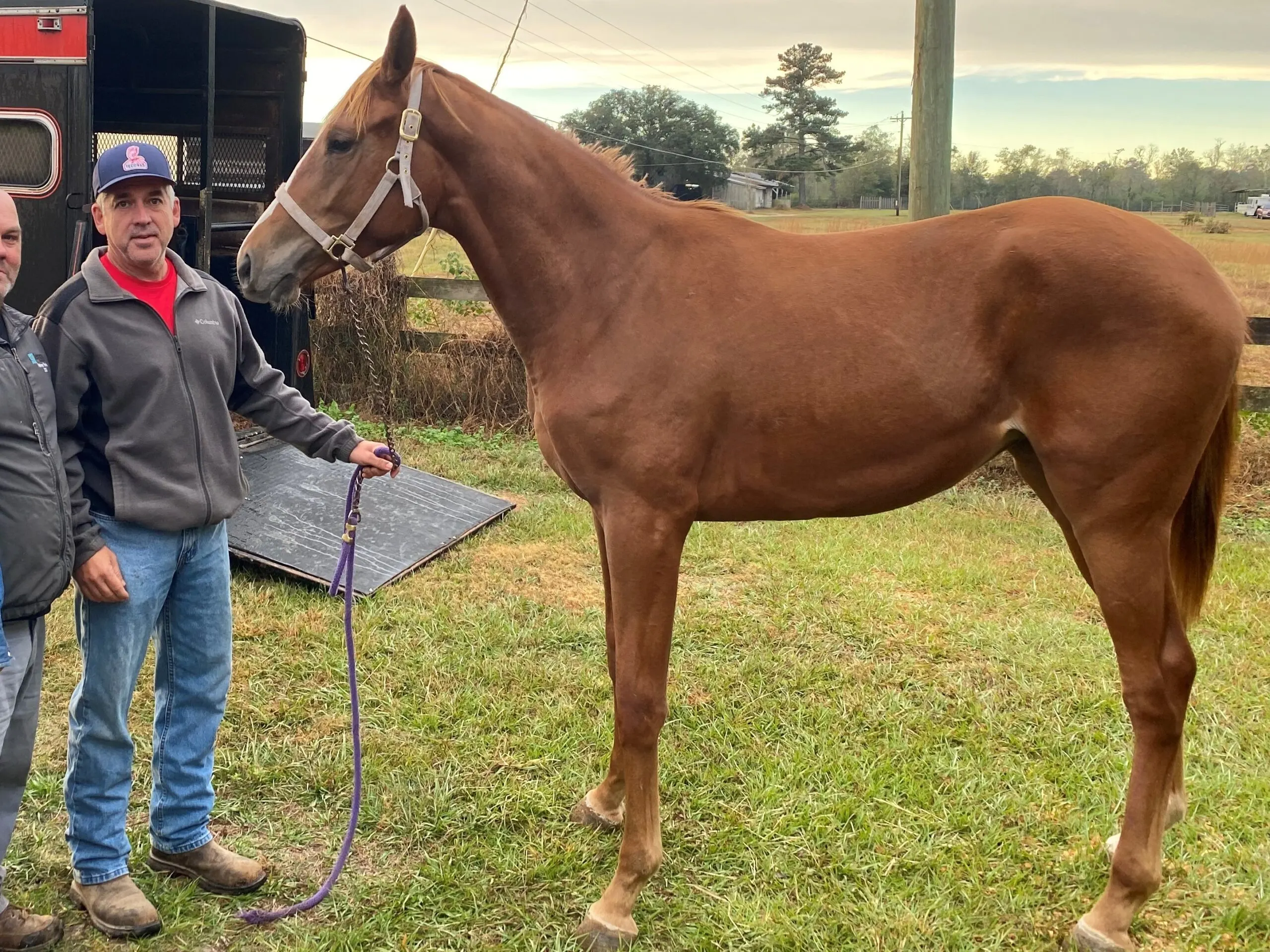Last updated: September 15, 2023
Any links on this page that lead to products on Amazon are affiliate links and I earn a commission if you make a purchase. Thanks in advance – I really appreciate it!
Every morning, my day begins in the barn, feeding our horses and ensuring they have access to clean, fresh water. The ritual for our pasture horses involves diligently checking the troughs’ water levels and topping them off as needed. It might seem routine, but it’s an essential task.
Through years of experience, I’ve learned that the best horse water troughs are durable and easy to maintain. Typically crafted from metal, plastic, or rubber, many of these troughs come equipped with a float valve for automatic refilling. While buckets are our go-to in most stalls, we’ve also integrated automatic waterers in one of our barns for added efficiency.
Ultimately, horse troughs play a pivotal role in equine care. They ensure horses remain hydrated with fresh water, whether they’re in pastures, paddocks, or barns. Moreover, these containers are more than just a water source; they’re tools to monitor your horse’s water consumption, a crucial aspect of their health.
In this guide, we discuss different kinds of watering options for horses. In particular, I cover:
- Best automatic waterer for horses
- Best troughs for pastures
- Best water buckets for horse stalls
- Why do horses need a water trough?
- Do horses need water at all times?
- Where to locate your horse trough?
- And more…
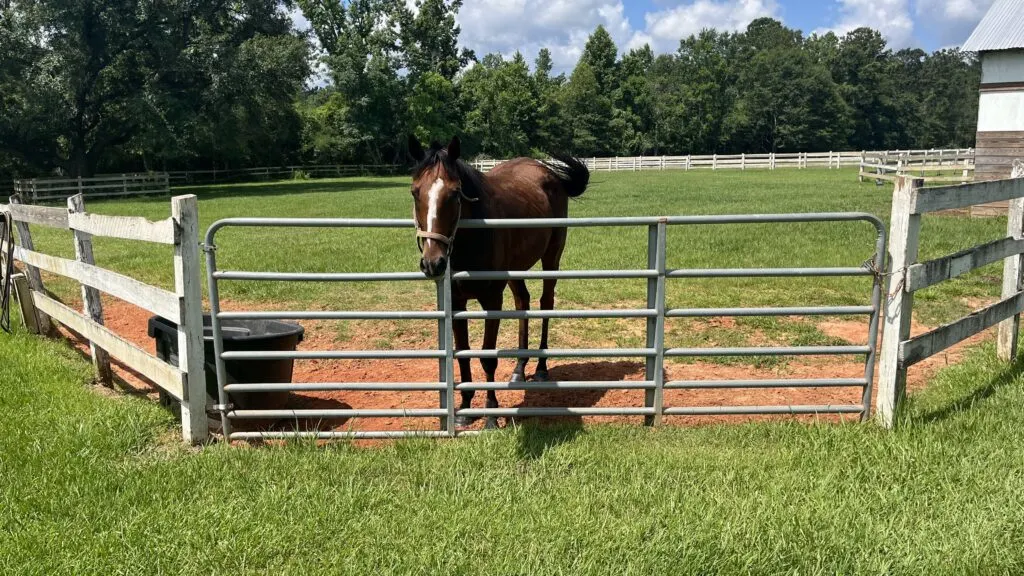
Why Do Horses Need a Water Trough?
For any horse owner, providing water for their animal is a necessity. You should have a good quality drinking system in place, and for pastures, a water trough is the best choice. Here are some reasons horses need a water trough:
1. Health
All horses need a continuous supply of fresh, clean water for nearly all life processes -especially digestion. When horses get dehydrated from a lack of water, they can’t absorb the nutrients they consume through their food. Water also helps the forage move through its intestines, processes it, and breaks down the concentrated grain products.
2. Prevents water wastage
High-quality troughs can save water. Many horses play with their water tanks and even tilt or toss out the water. A high-quality, sturdy trough can prevent this, as horses can’t tip them over.
3. Prevents impurities in water
A good trough with a drain hole or an automatic waterer with a filter can prevent debris in the water. Many horses drop grass or hay in water, which sinks to the bottom of troughs and rots. A trough with a drain hole can help you easily remove the contaminated water and easily refill it with fresh and clean water.
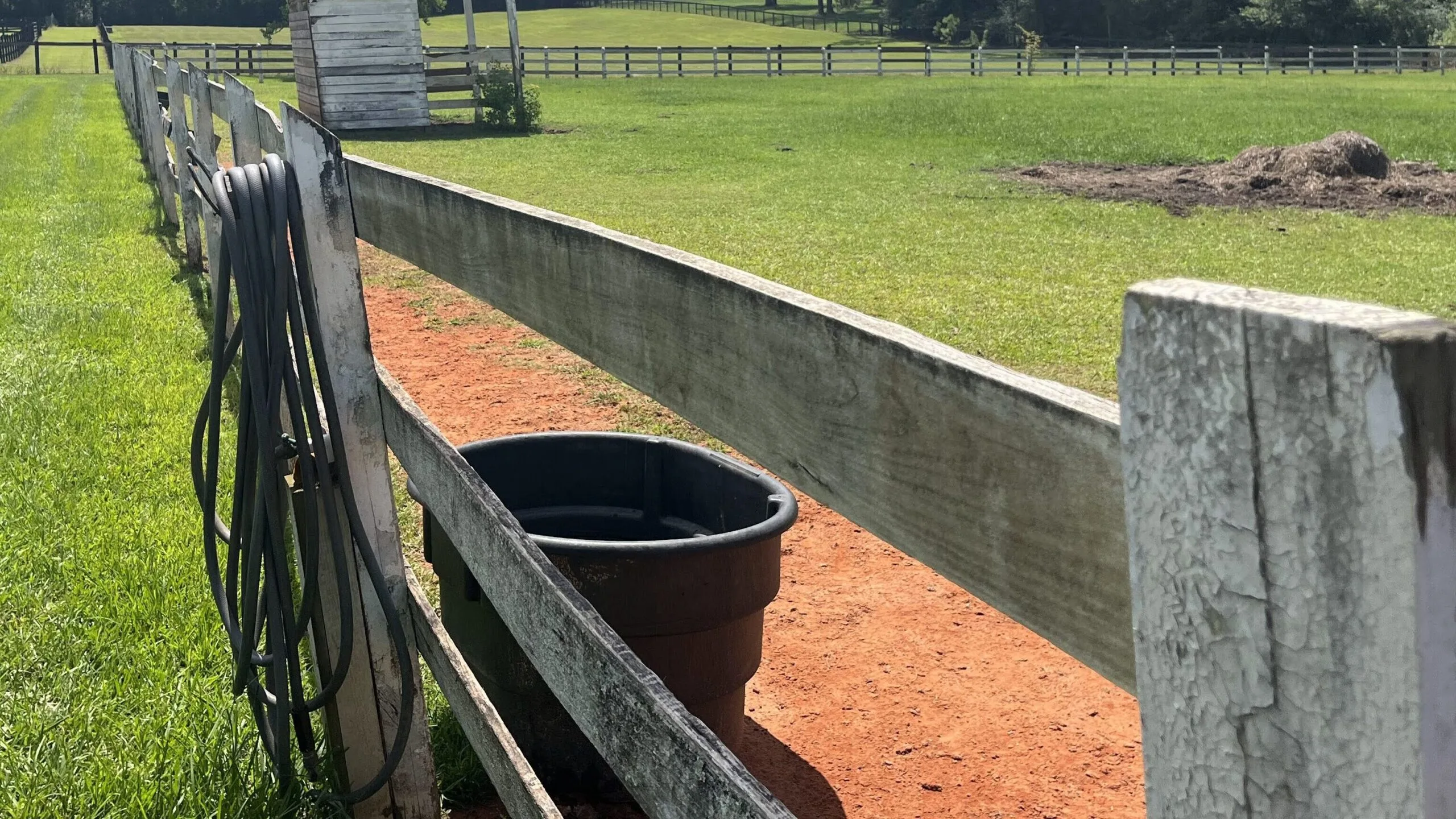
Do Horses Need Water at All Times?
Water is a vital necessity for all living creatures. Horses need water to help them digest their food, keep their coats healthy, and maintain their body temperature. A horse typically drinks a gallon of water per 100 pounds of body weight, or about 10 gallons a day for a normal-sized animal.
When water is not available, horses will drink whatever they can find, including muddy water from puddles or water troughs. This can lead to colic or other health problems. For these reasons, it is important to make sure that horses have access to water at all times.
Here are some essential reasons your horse should have access to water at all times:
1. Diet
- A horse that consumes an all-hay diet will drink more water than one that is on a pelleted diet.
- Likewise, a horse that consumes more salt will drink more water since salt stimulates urine.
- Horses on high-protein diets also tend to need more water to expel the nitrogen.
2. Physical condition and overall health
- A fat horse will take in less water than a horse with a good body conditioning score.
- Horses that are regularly exercised will also take in more water to replenish the water lost through urine.
- A lactating mare loses water through her milk and will need more water too.
3. Exercise
It is essential not to allow a hot or heavily exercised horse to drink too much water right away. This can result in water founder. Only allow a sweaty, tired horse to have a few sips of water. Let its body cool down entirely, after which you can make a free choice of water available again.
4. Weather
Horses in freezing conditions will intake less water than those in hot and humid conditions. While they do not drink too much water in winter, horses still need a fresh supply of water. They cannot survive by eating ice and snow. That is why a water trough with a heater is necessary to prevent the water in the trough from freezing over.
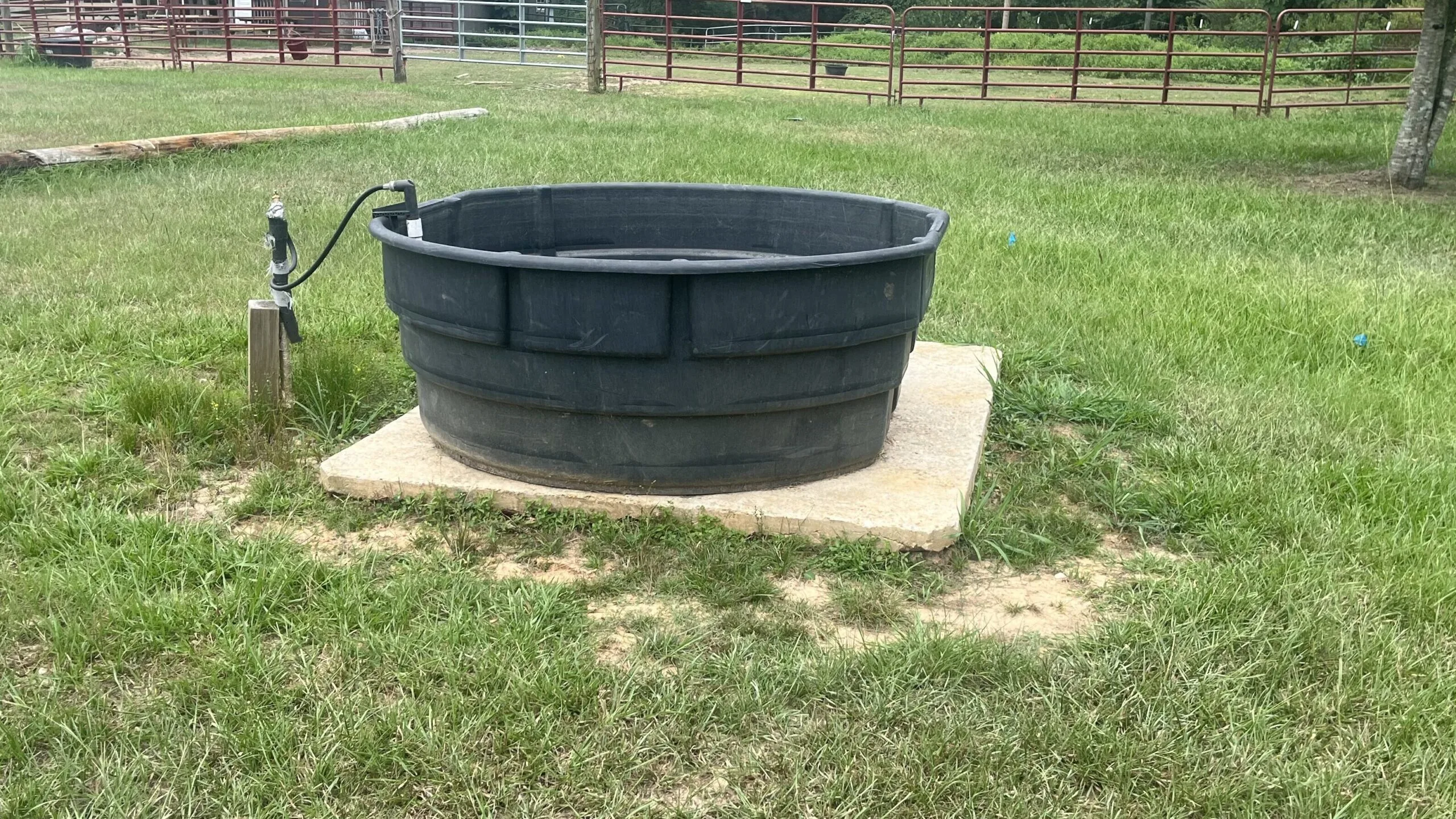
Factors to Consider When Choosing a Horse Trough
When it comes to watering your horses, you want a water trough that is durable, doesn’t leak, and is easy to clean. There are a variety of water troughs on the market, so how do you choose the best one for your needs?
One important factor to consider is the material the water trough is made from. Polyethylene and galvanized dipped metal are two popular materials for water troughs because they are strong and won’t corrode.
Another factor to keep in mind is the size of the water trough. If you have a large number of animals, you’ll need a larger water trough. Finally, you’ll want to think about how easy the water trough is to clean.
If it’s difficult to access, you may have a more difficult time keeping it clean. With these factors in mind, you can choose the best water trough for your field or pasture.
Best Water Troughs for Fields and Pastures
Rubbermaid Stock Tank
We’ve used many types of water troughs in our pastures, and for me, the most critical features are capacity, durability, and easy draining. This Rubbermaid water trough checks all the boxes.
- Oversized drain plug for easy draining and cleaning
Prices pulled from the Amazon Product Advertising API on:
Product prices and availability are accurate as of the date/time indicated and are subject to change. Any price and availability information displayed on [relevant Amazon Site(s), as applicable] at the time of purchase will apply to the purchase of this product.
Rubbermaid stock tanks are available in different sizes, from 50 to 300 gallons. These ergonomic and ultra-durable troughs are ideal for watering horses and have myriad uses. It also comes with an easy-to-use drain plug, which makes cleaning and moving it easy.
Features
- Made using durable polyethylene resin
- Molded-in rim eliminates hurting your hands while handling and also the horses’ lips
- All troughs over 100 gallons come with a drain plug and you can order a water level control separately that fits all the tanks.
- Dimensions -58 x 39 x 25 inches Oval shape.
Pros
- Ergonomically designed and difficult to flip
- Sturdy and well-built
- Drain plug included on models of 100 gallons or more.
- Easy to clean
Cons
- The drain plug is easy to strip out, so be careful when screwing it back.
CountyLine Galvanized Oval Stock Tank
I don’t particularly like galvanized water troughs because most will develop a leak at their seams. Plus, most don’t have a drain plug and often rust. But if you’re determined to get a galvanized water trough, I recommend the Oval CountyLine stock tank.
It can hold 100 gallons, and you can pick it up at your local Tractor Supply store. I find Tractor Supply has a good return policy, plus the manufacturer offers a 1-year warranty. Here are some of its salient features:
Features
- 2 ft. W x 2 ft. H x 4 ft. L stock tank
- Made with hot-dipped galvanized steel and zinc coating for a watertight seal
- 1-year limited warranty
Pros
- Sturdy and durable
- Leak-proof and rust-resistant
- Multi-purpose – can be used for more than watering horses
- Easy to clean
- Does not get tipped over by horses
Cons
- The finish is a bit rough. Some horses’ lips get scraped when they drink. So you may need to file down the rough edges.
Best Water Buckets for Horse Stalls
When it comes to horse stalls, water buckets are essential for providing a source of fresh water for your horse. But with so many different buckets on the market, how do you choose the best one for your horse? Here are a few things to keep in mind when selecting water buckets for your horse stall:
- The material: buckets can be made from plastic, metal, or even rubber. Each material has its own advantages and disadvantages. For example, plastic buckets are lightweight and easy to clean, but they can become brittle and crack over time. Metal buckets are more durable, but they can rust if not cleaned properly. Rubber buckets are the most expensive option, but they’re also the most durable and won’t rust or crack.
- The shape: What style bucket will meet your needs, a corner, flat back, or round bucket? It is crucial that your bucket has smooth edges to prevent injuries, and they should be easy to clean and disinfect.
- The size: buckets come in a variety of sizes; it’s important to choose a size that’s appropriate for your horse’s needs. For example, if you have a large horse that drinks a lot of water, you want to have a big water bucket.
Horze Flat Back All Purpose Bucket
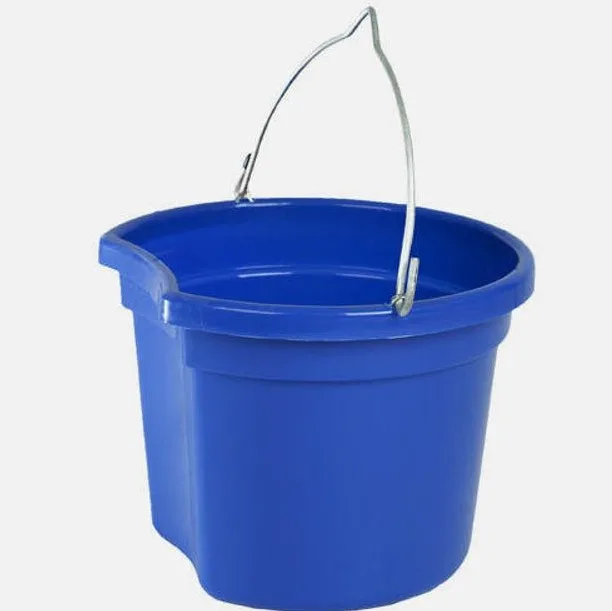
I like to use flat-back buckets in my horse stalls because they stay in place better than your typical round buckets. Horze makes a durable one, and it’s marked on the side to indicate quarts, gallons, and liters, which is helpful when mixing supplements.
Here are some of the other great features:
- 2.5-gallon capacity
- Strong galvanized bail and eyelet assembly
- It’s thick enough to resist collapsing from the weight of liquids
- It has a handy handgrip on the bottom for easy pouring
- Made of a durable rubber blend for exceptional strength even at low temperatures
Little Giant Plastic Animal Feed Bucket
Little Giant also makes a good water bucket, it’s a little more expensive than the Horze buckets, but these are available on Amazon. Both are suitable buckets, but besides seeing these used in other barns, I haven’t used them.
- ERGONOMIC DESIGN - The flat-back plastic bucket is perfect for hanging and features stacking ribs so pails come apart easier when stacked.
Prices pulled from the Amazon Product Advertising API on:
Product prices and availability are accurate as of the date/time indicated and are subject to change. Any price and availability information displayed on [relevant Amazon Site(s), as applicable] at the time of purchase will apply to the purchase of this product.
However, I did talk to a trainer and some of my friends that use these buckets and they claim they are incredibly sturdy and well-made, and the metal handle is a thicker gauge than most buckets. It also has plastic covers over the ends of the handles.
It is versatile, and you can put it to numerous uses.
Features
- Available in various sizes like 2 gallons, 5 gallons, and 5.5 gallons and nearly 13 attractive color choices
- Made with polyethylene resin
- Wire bail for hanging
Pros
- Easy to stack with similar buckets/buckets from the same brand
- A notch on the handle facilitates easy hanging
- Sturdy and durable
- Value for money
- Great for gifting
Cons
- The handle isn’t easy on the hands.
Best Automatic Waterer for Horses
Automatic waterers are a great way to ensure that your horses have access to clean water, but it is crucial to select one that is well-designed. Several factors should be considered when choosing an automatic waterer, including float design, construction material, and size.
I didn’t have good luck with our automatic waterer. First, it had a small bowl that held just a little water, so it needed to run constantly when the horses were drinking. Next, the float got stuck in the upright position often and didn’t release water.
The waterer was made from galvanized steel and was hard to clean. To wipe behind the flap, I had to remove the entire waterer from the stall wall and take it apart. Another problem you can run into is dripping over the edge.
If these are not installed level, some will constantly leak. I moved away from using automatic waterers in our stalls. I strongly suggest you consider these factors when picking out an automatic water trough for your horse.
RabbitNipples Automatic Farm Grade Stainless Steel Horse Waterer
The RabbitNipples automatic waterer has some features I don’t like, such as the small bowl, but it is made of stainless steel, which I like better than the galvanized ones I had in my barn. But I still have concerns about the float.
However, customers love this automatic waterer, and if you intend to try one, this is the one I suggest. It has numerous features that make it a bestseller:
- Automatic stock waterer for horses, Goats, Sheep, Dogs and other outside animals
Prices pulled from the Amazon Product Advertising API on:
Product prices and availability are accurate as of the date/time indicated and are subject to change. Any price and availability information displayed on [relevant Amazon Site(s), as applicable] at the time of purchase will apply to the purchase of this product.
Features
- Dimensions: – 11.5″ w x 10″L x 5″ d
- Reversible water inlet – can be attached to the right
- Made with rust-resistant stainless steel
Pros
- Multi-purpose: can be used for horses, cows, goats, etc.
- Steady pressure and safe operation at 1 to 50 psi
- Can be installed easily
- Rust-resistant
Cons
- Plumbing parts are made of plastic. Some did not last long.
- No drain was provided. Cleaning and emptying out dirty water is tedious.
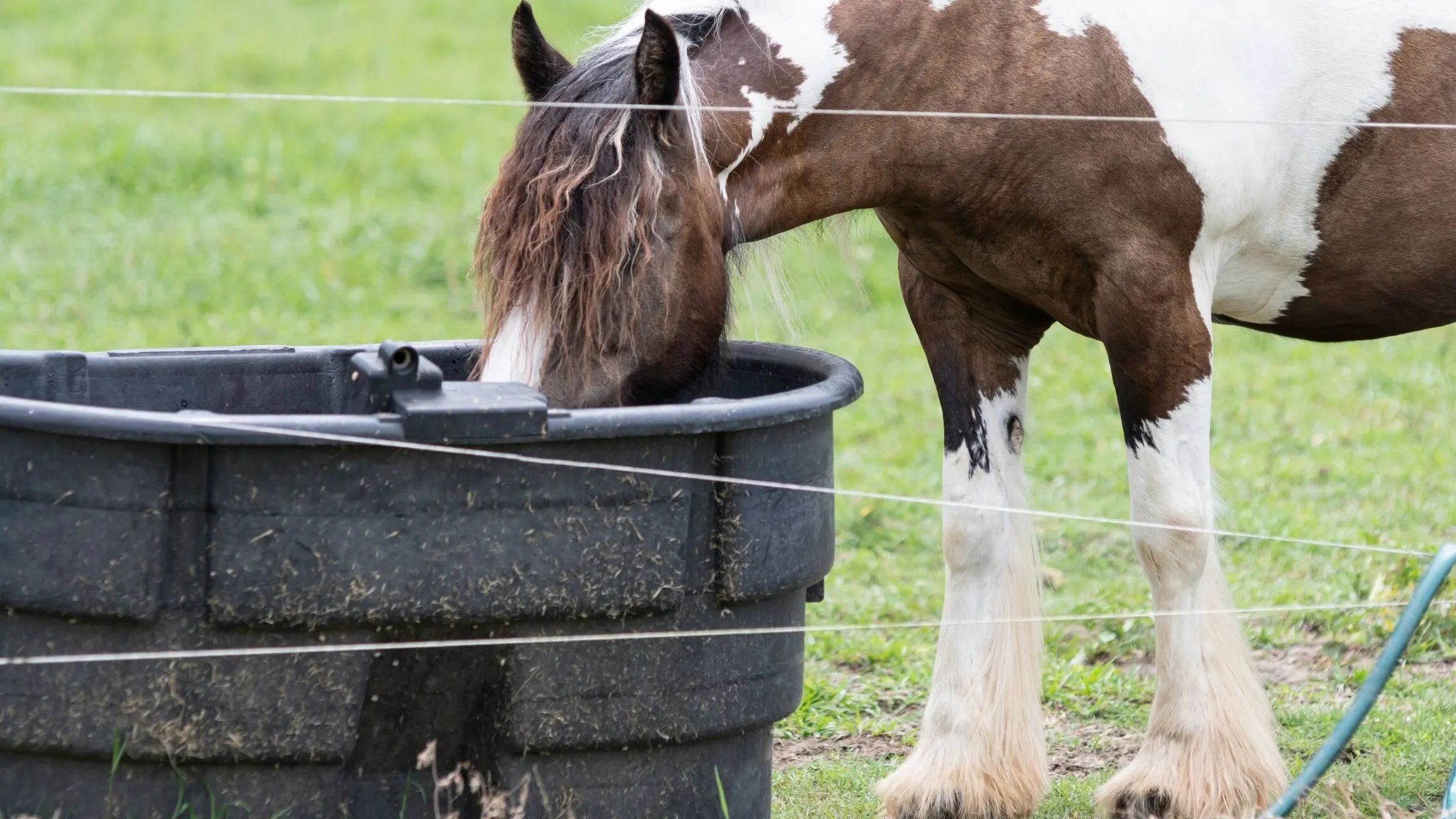
Where to Locate Horse Water Trough?
Here are some tips for optimum water trough placement:
- Locate the water trough in an area with good natural drainage.
- In pastures having multiple horses, locate several water troughs in multiple places so they can drink at the same time. This is important to prevent aggressive behavior and injuries at the trough.
- In an open pasture, locate the trough on gravel and make sure that the gravel extends at least 10 ft. beyond the trough. This will prevent the ground underneath it from turning into a mudhole.
- I typically put my trough against a fence and near a water spigot so that it’s easy to fill. Some people suggest keeping it away from fences to prevent cats, coons, and other animals from drinking, but I disagree with this.
- Check the water troughs regularly and immediately remove debris, dead rodents, etc.
Can Horses Get Sick from Drinking Dirty Water?
Yes, horses could get sick from drinking contaminated or dirty water. Dirty water can lead to loose, watery stools (diarrhea), colic, and in worse cases, even poisoning in horses. A horse could even die after drinking contaminated water.
How to Keep Your Horse’s Water Clean?
If you don’t keep your horse’s water clean, it can turn sour-smelling, and your horse might stop drinking altogether. This can cause a host of problems. The best ways to keep your horse’s water clean are as follows:
- Locate the water troughs away from posts where rodents and birds’ droppings cannot fall in.
- It is best to keep the troughs in the shade, as scum and algae form more quickly in sunlight.
- You can use automatic waterers that come with filters. These ensure clean and fresh water for the most part. However, even automatic waterers need a thorough cleaning from time to time.
- Check your horse’s water trough daily and give it a good scrubbing regularly to remove algae and mold. Use a wire brush to prevent algae from coating the sides and bottom of the tank.
- Remove all the floating debris immediately before it sinks to the bottom of the trough.
- Add products like Airmax Stock Tank Defense Dissolving Tablets, which add beneficial bacteria to the water and also remove debris. It can also improve the trough water’s clarity.
- Some people add fish like goldfish to horse water troughs. These keep the water clean as the fish eat mosquito larvae and other pests.
How Often to Clean Horse Buckets and Troughs?
Proper horse care includes keeping water buckets clean. I typically wash out our water buckets every day, it doesn’t take long to do, and it’s a good practice. For pasture water troughs, I clean them when they need cleaning. For some, it may be once a week, and for others, monthly.
How often the trough needs cleaning depends on where the trough is kept, the time of year, and how much water the horses drink.
To clean stall buckets, all you need to do is rinse them out and wipe them out with a rag or sponge. To clean a pasture trough, drain all the water, squirt some Dawn or other dishwashing detergent inside the trough, and add water. Next, use a brush or mop to wipe it down well, rinse it, and let it dry in the bacteria-killing sunshine.
I had a Western horse that refused to drink unless it had fresh, clean water, which wasn’t a problem when I kept him in the barn, but when I turned him out in the pasture, he wouldn’t drink from the trough. So I hung a clean bucket of water on the fence, and he was drinking again.
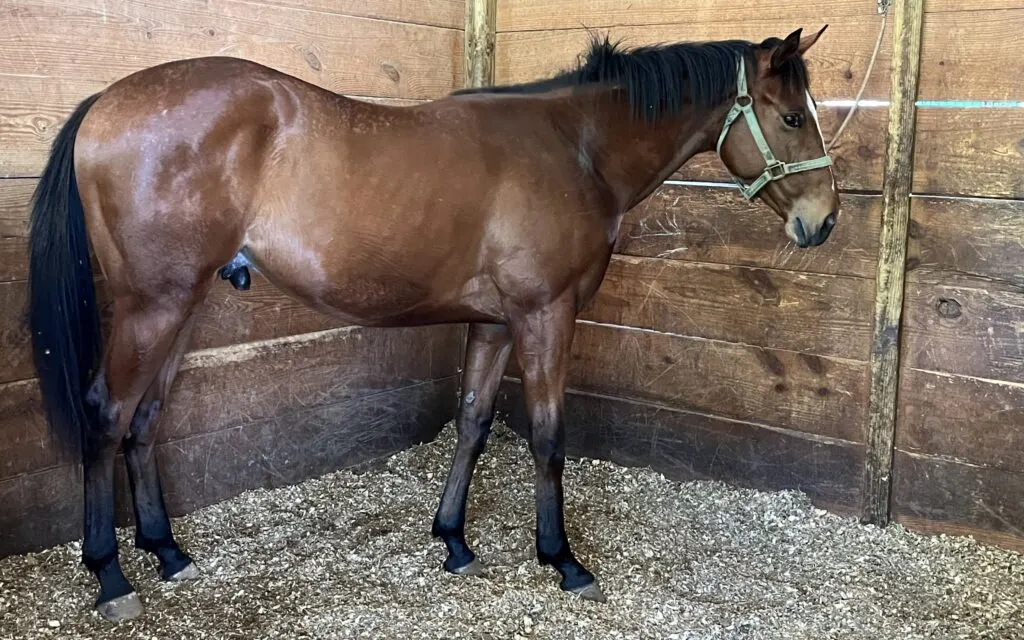
Are Automatic Waterers Good for Horses?
Automatic waterers come with their sets of pros and cons. Some horse owners believe they are the best way to provide fresh water, but I don’t see it this way. When I used automatic waterers, they often jammed and would flood the stall.
And we have clay floors in our stalls with wood shavings, so the water caused a serious mess. But I have friends who swear by them; here are the benefits they tout:
#1. Clean water
With automatic waterers, water gets replenished in the drinking pot each time your horse drinks. This ensures a clean supply of water at all times. Also, such systems come with filters that clean away debris, sediments, and even chemical impurities from water.
#2. They keep horses better hydrated
A good automatic waterer will ensure that your horse/s is always hydrated. This can reduce colic, improve digestion, and also their performance.
#3. Better for the owners
Refilling horse water troughs can be a chore, especially if you keep several horses. With automated water refill systems, you can prevent this refilling. They are also easier to clean compared to cleaning several water buckets and troughs.
#4. Deters mosquito breeding
Water troughs and open water buckets are a surefire invitation to mosquitoes and other pests. Mosquito larvae flourish in the breeding grounds created by water troughs. Automatic waterers have a smaller surface area with water, and they also have flowing water, which deters these pests.
#5. Can save money and precious water
Many farm owners leave the hose on accidentally – sometimes all night – when they forget to switch it off while refilling troughs. With automatic systems, you avoid this problem and save water.
Conclusion & Final Recommendation
Ensuring a dependable water source for horses is paramount. The ideal watering system largely depends on the number of horses, pasture size, and whether the horses are stabled. While horse water troughs remain a favorite in the horse world, many owners prefer large individual water buckets.
Some even opt for automatic water systems. On a side note, while trail riding at Bogue Chitto State Park, we were pleasantly surprised to find large water troughs along the way — a thoughtful gesture for our equine companions.
Below is a YouTube video with tips for keeping your horse water bucket clean and cool.
FAQs
How big a water trough does a horse need?
The size of a water trough depends on how many horses are drinking from it and the size of your pasture. If you keep several horses, you need a 150-gallon capacity water trough. For 1-2 horses, a small trough of 25 gallons should be adequate.
Do horse water troughs rust?
Metal troughs can rust. So, look for troughs made of galvanized steel (zinc coating); this helps prevent rusting.
How much does a horse water trough cost?
A 300-gallon Rubbermaid horse trough costs close to $400, and a 16-gallon Behrens galvanized steel trough costs $70. There is a wide range in prices depending on their material and size.
Meet Miles Henry
An avid equestrian and seasoned racehorse owner, Miles Henry brings his extensive experience to the equine world, proudly associating with the AQHA, The Jockey Club, and various other equine organizations. Beyond the racetrack, Miles is an accomplished author, having published various books about horses, and is a recognized authority in the field, with his work cited in multiple publications.
🔗 Connect with Miles:
Twitter
Facebook
YouTube: Check out race highlights, horse care tips, and more!




